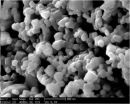New solar power material converts 90 percent of captured light into heat
SunShot Project aims to make solar cost competitive
2014-10-29
(Press-News.org) A multidisciplinary engineering team at the University of California, San Diego developed a new nanoparticle-based material for concentrating solar power plants designed to absorb and convert to heat more than 90 percent of the sunlight it captures. The new material can also withstand temperatures greater than 700 degrees Celsius and survive many years outdoors in spite of exposure to air and humidity. Their work, funded by the U.S. Department of Energy's SunShot program, was published recently in two separate articles in the journal Nano Energy.
By contrast, current solar absorber material functions at lower temperatures and needs to be overhauled almost every year for high temperature operations.
"We wanted to create a material that absorbs sunlight that doesn't let any of it escape. We want the black hole of sunlight," said Sungho Jin, a professor in the department of Mechanical and Aerospace Engineering at UC San Diego Jacobs School of Engineering. Jin, along with professor Zhaowei Liu of the department of Electrical and Computer Engineering, and Mechanical Engineering professor Renkun Chen, developed the Silicon boride-coated nanoshell material. They are all experts in functional materials engineering.
The novel material features a "multiscale" surface created by using particles of many sizes ranging from 10 nanometers to 10 micrometers. The multiscale structures can trap and absorb light which contributes to the material's high efficiency when operated at higher temperatures.
Concentrating solar power (CSP) is an emerging alternative clean energy market that produces approximately 3.5 gigawatts worth of power at power plants around the globe—enough to power more than 2 million homes, with additional construction in progress to provide as much as 20 gigawatts of power in coming years. One of the technology's attractions is that it can be used to retrofit existing power plants that use coal or fossil fuels because it uses the same process to generate electricity from steam.
Traditional power plants burn coal or fossil fuels to create heat that evaporates water into steam. The steam turns a giant turbine that generates electricity from spinning magnets and conductor wire coils. CSP power plants create the steam needed to turn the turbine by using sunlight to heat molten salt. The molten salt can also be stored in thermal storage tanks overnight where it can continue to generate steam and electricity, 24 hours a day if desired, a significant advantage over photovoltaic systems that stop producing energy with the sunset.
One of the most common types of CSP systems uses more than 100,000 reflective mirrors to aim sunlight at a tower that has been spray painted with a light absorbing black paint material. The material is designed to maximize sun light absorption and minimize the loss of light that would naturally emit from the surface in the form of infrared radiation.
The UC San Diego team's combined expertise was used to develop, optimize and characterize a new material for this type of system over the past three years. Researchers included a group of UC San Diego graduate students in materials science and engineering, Justin Taekyoung Kim, Bryan VanSaders, and Jaeyun Moon, who recently joined the faculty of the University of Nevada, Las Vegas. The synthesized nanoshell material is spray-painted in Chen's lab onto a metal substrate for thermal and mechanical testing. The material's ability to absorb sunlight is measured in Liu's optics laboratory using a unique set of instruments that takes spectral measurements from visible light to infrared.
Current CSP plants are shut down about once a year to chip off the degraded sunlight absorbing material and reapply a new coating, which means no power generation while a replacement coating is applied and cured. That is why DOE's SunShot program challenged and supported UC San Diego research teams to come up with a material with a substantially longer life cycle, in addition to the higher operating temperature for enhanced energy conversion efficiency. The UC San Diego research team is aiming for many years of usage life, a feat they believe they are close to achieving.
Modeled after President Kennedy's moon landing program that inspired widespread interest in science and space exploration, then-Energy Secretary Steven P. Chu launched the Sunshot Initiative in 2010 with the goal of making solar power cost competitive with other means of producing electricity by 2020.
INFORMATION:
ELSE PRESS RELEASES FROM THIS DATE:
2014-10-29
Washington D.C, October 29, 2014 -- Ant nests can offer a lot to organisms other than just ants. They are well-protected, environmentally-stable and resource-rich spaces -- in many ways everything a tiny creature could ask for in a home. So long as you can live with an army of ants of course.
For the thousands of species of insects that squat inside ant nests, survival means finding ways to live with the ants -- by foiling the chemical cues ants use to distinguish friend from foe, for instance. Now a team of scientists from the University of Turin in Italy have been ...
2014-10-29
CHICAGO, IL, OCTOBER, 29, 2014 – According to a new, wide-reaching collection of scientific reviews published in the October 2014 supplement issue of the British Journal of Nutrition, oats may play an important role in improving satiety, diet quality and digestive, cardiovascular and general metabolic health. In the supplement issue, entitled "Oats, More Than Just a Whole Grain," scientists from around the world explore the oat from agriculture and sustainability to nutrition policy and opportunity and new insights in nutritional science that go beyond cardiovascular ...
2014-10-29
Black Republicans trust the United States government more than other political groups, finds a new study from the University of British Columbia, ahead of the mid-term U.S. elections to be held on November 4.
Using election data from 1958 – 2012, the study measures the role race plays in determining levels of government trust for black and white Americans. While both groups show similar levels of political trust, when party lines are factored in, black Republicans are revealed to be the most faithful.
"Being both black and Republican is seen by some as going against ...
2014-10-29
CAPE TOWN, October 29, 2014 – Many of the women at first acted surprised. Some insisted the blood tests were wrong. But most conveyed to researchers why they had not used the study products assigned to them as participants in VOICE, a large HIV prevention trial that, as a likely consequence, did not find any of the three products that were tested to be effective.
The women were among 127 former VOICE participants who, as part of a behavioral sub-study called VOICE D, agreed to take part in in-depth interviews and/or focus group discussions after learning the results ...
2014-10-29
New research by the international Cancer Genomics of the Kidney consortium (CAGEKID) reveals an important connection between kidney cancer and exposure to aristolochic acid, an ingredient in some herbal remedies. The findings, published in Nature Communications, have important implications for public health.
Kidney cancer kills more than 140,000 people every year, and in Central Europe incidence rates have been increasing dramatically. CAGEKID, part of the International Cancer Genome Consortium (ICGC), has been studying the genetic causes of this disease in Europe. The ...
2014-10-29
A new study on a large cohort of kidney cancer patients in Europe sheds light on the genetic architecture of the disease -- and reveals an apparent link between exposure to aristolochic acid and incidence of kidney cancer, particularly in Romania.
The research, by an international team led by scientists from the McGill University and Genome Quebec Innovation Centre in Montreal, underscores the importance of investigating possible sources of exposure to aristolochic acid. The compound, found in plants of the Aristolochia genus, also has been suspected of causing a kidney ...
2014-10-29
Sophia Antipolis, 20 October 2014. The condition of an athlete's heart has for the first time been accurately monitored throughout the duration of a marathon race. The real-time monitoring was achieved by continuous electrocardiogram (ECG) surveillance and data transfer over the public mobile phone network to a telemedicine centre along the marathon route. This new development in cardiac testing in endurance athletes, said investigators, "would allow instantaneous diagnosis of potentially fatal rhythm disorders".
Following trails in two marathon races, the investigators ...
2014-10-29
Eating Mediterranean or DASH-style diets, regularly engaging in physical activity and keeping your blood pressure under control can lower your risk of a first-time stroke, according to updated AHA/ASA guideline published in the American Heart Association's journal Stroke.
"We have a huge opportunity to improve how we prevent new strokes, because risk factors that can be changed or controlled — especially high blood pressure — account for 90 percent of strokes," said James Meschia, M.D., lead author of the study and professor and chairman of neurology at the ...
2014-10-29
OAK BROOK, Ill. – Researchers using a combination of different imaging techniques have found structural abnormalities in the brains of people with chronic fatigue syndrome (CFS), according to a new study published online in the journal Radiology. The results suggest a potential role for imaging in diagnosing and treating the condition.
CFS is characterized by profound fatigue and "brain fog" that do not improve with bed rest, lasting for at least six months. The condition affects more than 1 million adults and children in the United States, according to the Centers ...
2014-10-29
An imaging study by Stanford University School of Medicine investigators has found distinct differences between the brains of patients with chronic fatigue syndrome and those of healthy people.
The findings could lead to more definitive diagnoses of the syndrome and may also point to an underlying mechanism in the disease process.
It's not uncommon for CFS patients to face several mischaracterizations of their condition, or even suspicions of hypochondria, before receiving a diagnosis of CFS. The abnormalities identified in the study, to be published Oct. 29 in Radiology, ...
LAST 30 PRESS RELEASES:
[Press-News.org] New solar power material converts 90 percent of captured light into heat
SunShot Project aims to make solar cost competitive





